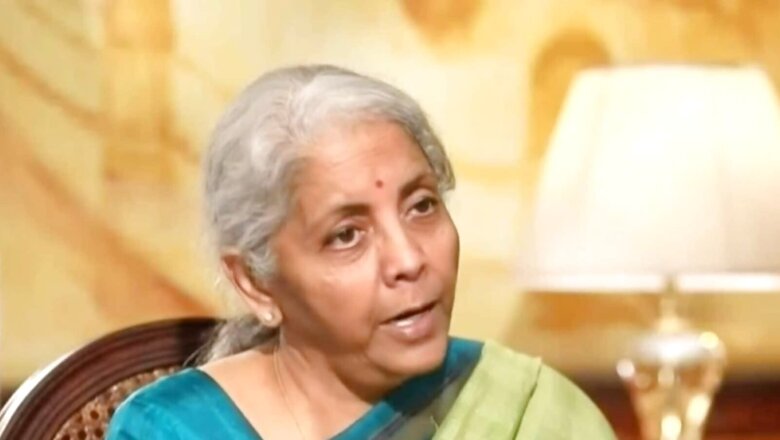
views
Union minister of finance Nirmala Sitharaman recently said that the biggest risk of cryptocurrency in the midst of the pioneering fintech revolution is money laundering and its use to finance terrorism.
Sitharaman said this at a session during the ongoing spring meeting of the International Monetary Fund (IMF). It was her opinion that “the biggest risk for all countries across the board will be the money laundering aspect and also the aspect of currency being used for financing terror”.
Additionally, the finance minister also noted that the only solution is to regulate utilising technology.
However, she said that regulation based on technology is the only way to deal with cryptocurrencies and added that it must be “so adept” that it is “not behind the curve, but on top of it”.
The minister also emphasised India’s success in the digital world and the government’s efforts over the previous decade to build the country’s digital infrastructure framework, stating that the government’s increased rate of technology adoption during the Covid-19 pandemic.
“If I use 2019 data, the digital adoption rate in India is about 85 per cent. But globally that same year it was only somewhere near 64 per cent. So the pandemic time actually helped us to test and prove for ourselves that it is simple to use, common people can use it, and adoption actually was proven,” she said.
During an IMF-hosted high-level panel discussion, Sitharaman stated that regulating digital assets used for non-governmental reasons via unhosted wallets would be practically difficult.
Sitharaman explained that taxing money generated by virtual asset exchanges is a way to verify the source and trail of the funds, but not to legalise them.
Crypto And Crimes
Money laundering is one of the most common crimes in the crypto sector, with cases increasing by over 30 per cent between 2020 and 2021, according to Chainalysis’s 2022 Crypto Crime Report.
According to the same analysis, criminals laundered $8.6 billion in cryptocurrency in 2021. In 2020, it was $6.6 billion. Between 2017 and 2021, the year 2019 saw the biggest amount of money laundered, at $10.9 billion.
In the case of India, Pankaj Chaudhary, minister of state for finance, said in March that the Centre is aware of cybercriminals using digital assets for money laundering.
He said in Parliament: “Reports have been received from Law Enforcement Agencies (LEAs) in connection with the usage of cryptocurrency by cybercriminals. The Directorate of Enforcement (ED) is investigating 07 cases under PMLA (Prevention of Money Laundering Act), 2002 in which cryptocurrency has been used for money laundering.”
“Cases investigated by ED under PMLA, reveal that the accused have laundered Proceeds of Crime (PoC) through cryptocurrency,” he added.
So far, ED investigations have revealed that some foreigners and their Indian collaborators have used cryptocurrency accounts at select exchange platforms to launder the proceeds of crime.
In one such case, the ED detained an accused in 2020 for assisting foreign-related accused firms in laundering the PoC by changing money obtained via criminal activity into cryptocurrencies and then transferring it to foreign nations.
It is claimed that the criminals transact utilising only a few crypto coins when they target certain crypto services for their illicit money laundering activities.
According to Chainalysis, altcoins obtained the biggest percentage of all unlawful transactions (68%) while bitcoins received the least (19 per cent). Money laundering was found to be 63% in ethereum and 57% in stablecoins.
However, while discussing digital assets, Sitharaman talked about the benefits of central bank digital currencies over cryptocurrency. She stated that India’s CBDC programme will take place this year.
Sitharaman’s comments come several weeks after India imposed a 30 per cent tax on digital assets in an attempt to discourage investors from trading bitcoin. Last month, the Indian government stated that it has no plans to introduce cryptocurrency.
‘Grave concerns’
It is noteworthy that the Reserve Bank of India has raised “grave concerns” about private digital assets, warning that they could lead to financial instability.
However, Sitharaman attended an event at the Atlantic Council, a think tank in America’s Washington, DC, earlier this week in addition to her formal engagements with the World Bank, IMF, G20, and Financial Action Task Force (FATF).
According to a ministry of finance announcement, the visit would involve bilateral interactions with Indonesia, South Korea, Sri Lanka, and South Africa, as well as a high-level meeting with World Bank president David Malpass.
After the meetings in Washington, Sitharaman will go to San Francisco on April 24, where she will meet with business leaders and connect with Stanford University academics and students.
Read all the Latest Business News and Breaking News here




















Comments
0 comment